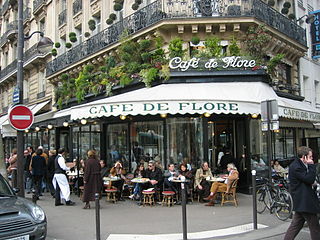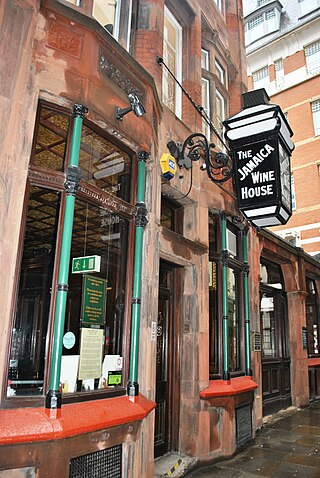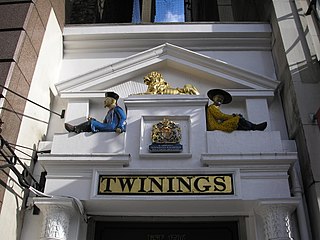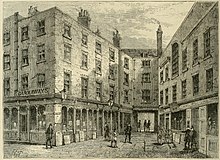
A coffeehouse, coffee shop, or café is an establishment that primarily serves various types of coffee, espresso, latte, and cappuccino. Some coffeehouses may serve cold drinks, such as iced coffee and iced tea, as well as other non-caffeinated beverages. A coffeehouse may also serve food, such as light snacks, sandwiches, muffins, fruit, or pastries. In continental Europe, some cafés also serve alcoholic beverages. Coffeehouses range from owner-operated small businesses to large multinational corporations. Some coffeehouse chains operate on a franchise business model, with numerous branches across various countries around the world.

Ludgate Hill is a street and surrounding area, on a small hill in the City of London, England. The street passes through the former site of Ludgate, a city gate that was demolished – along with a gaol attached to it – in 1760.

Threadneedle Street is a street in the City of London, England, between Bishopsgate at its northeast end and Bank junction in the southwest. It is one of nine streets that converge at Bank. It lies in the ward of Cornhill.

Jonathan's Coffee House was a significant meeting place in London in the 17th and 18th centuries, famous as the original site of the London Stock Exchange.

The Jamaica Wine House, known locally as "the Jampot", is located in St Michael's Alley, Cornhill, in the heart of London's financial district. It was the first coffee house in London and was visited by the English diarist Samuel Pepys in 1660. It is now a Grade II listed public house and is set within a labyrinth of medieval courts and alleys in the City of London. It lies in the ward of Cornhill.

The Twinings Museum was a small temporary museum adjacent to the Twinings shop at 216, Strand, in London, England.

Berry Bros. & Rudd (BBR) is a family-run British wine and spirits merchant founded in London, England, in 1698, although they didn't become wine merchants until the late 18th century. Since 1698, the company has grown from initially a small coffee shop, into an international business with six offices worldwide.

The Grecian Coffee House was a coffee house, first established in about 1665 at Wapping Old Stairs in London, England, by a Greek former mariner called George Constantine.

Exchange Alley or Change Alley is a narrow alleyway connecting shops and coffeehouses in an old neighbourhood of the City of London. It served as a convenient shortcut from the Royal Exchange on Cornhill to the Post Office on Lombard Street and remains as one of a number of alleys linking the two streets. Shops once located in Exchange Alley included ship chandlers, makers of navigation instruments such as telescopes, and goldsmiths from Lombardy in Italy.

The Stuart period in London began with the reign of James VI and I in 1603 and ended with the death of Queen Anne in 1714. London grew massively in population during this period, from about 200,000 in 1600 to over 575,000 by 1700, and in physical size, sprawling outside its city walls to encompass previously outlying districts such as Shoreditch, Clerkenwell, and Westminster. The city suffered several large periods of devastation, including the English Civil War and the Great Fire of London, but new areas were built from scratch in what had previously been countryside, such as Covent Garden, Bloomsbury, and St. James's, and the City was rebuilt after the Fire by architects such as Christopher Wren.

The George and Vulture is a restaurant in London. There has been an inn on the site, which is off Lombard Street in the historic City of London district, since 1142. It was said to be a meeting place of the notorious Hell-Fire Club and is now a revered City chop house.

The Gresham Club was founded in 1843 and dissolved in 1991. It was named after Thomas Gresham. The Gresham Club's last site was located on Abchurch Lane off King William Street before it was sold to the London Capital Club, which in turn ceased operation in 2018. Following the closure of the London Capital Club, a number of the members relaunched The Gresham Club in 2018 and recreated the raison d'être of its original predecessor.

Since the 18th century, the United Kingdom has been one of the world's largest tea consumers, with an average annual per capita supply of 1.9 kilograms (4.2 lb). Originally an upper-class drink in Europe, tea gradually spread through all classes, eventually becoming a common drink. It is still considered an important part of the British identity and is a prominent feature of British culture and society.

A Sally Lunn is a large bun or teacake, a type of batter bread, made with a yeast dough including cream and eggs, similar to the sweet brioche breads of France. Sometimes served warm and sliced, with butter, it was first recorded in 1780 in the spa town of Bath in southwest England. As a tea cake it is popular in Canada, England and New Zealand.

Tea has long been used as an umbrella term for several different meals. English writer Isabella Beeton, whose books on home economics were widely read in the 19th century, describes meals of various kinds and provides menus for the "old-fashioned tea", the "at-home tea", the "family tea", and the "high tea".

English coffeehouses in the 17th and 18th centuries were public social places where men would meet for conversation and commerce. For the price of a penny, customers purchased a cup of coffee and admission. Travellers introduced coffee as a beverage to England during the mid-17th century; previously it had been consumed mainly for its supposed medicinal properties. Coffeehouses also served tea and hot chocolate as well as a light meal.
Pasqua Rosée was a 17th-century servant who opened the first coffee-house in London and possibly Britain. He was born into the ethnic Greek community of the Republic of Ragusa. In 1651 he became the servant of Daniel Edwards, an English merchant of the Levant Company who was living in Smyrna in the Ottoman Empire; Rosée's duties included preparing and serving Edwards's daily coffee.

The Lamb and Flag is a Grade II listed public house at Rose Street, Covent Garden, London, WC2.

The City of London Tavern or London Tavern was a notable meeting place in London during the 18th and 19th centuries. A place of business where people gathered to drink alcoholic beverages and be served food, the tavern was situated in Bishopsgate in the City of London. The original tavern was destroyed in a fire on 7 November 1765 and the new building was designed by William Jupp the elder and opened in September 1768. In 1828, the proprietor was Charles Bleaden. The building was demolished in 1876. The tavern boasted a large and well-decorated dining room with Corinthian columns. It hosted numerous public and private meetings held to rally support to various political, charitable and other causes.

In Britain, a cafe, also known colloquially as a caff or greasy spoon, is a small, cheap eatery typically specialising in fried foods or home-cooked meals.






















